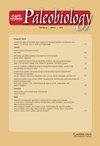Relative oversampling of carbonate rocks in the North American marine fossil record
IF 2.7
2区 地球科学
Q2 BIODIVERSITY CONSERVATION
引用次数: 0
Abstract
Paleontologists have long stressed the need to know how sampling the fossil record might influence our knowledge of the evolution of life. Here, we combine fossil occurrences of North American marine invertebrates from the Paleobiology Database with lithologic data from Macrostrat to identify sampling patterns in carbonate and siliciclastic rocks. We aim to quantify temporal trends in sampling effort within and between lithologies, focusing on the proportion of total available volume that has been sampled (sampled fossiliferous proportion, here called κ). Results indicate that the sampled fossiliferous proportion was stable during the Paleozoic, and variable during the post-Paleozoic, but showed no systematic increase through time. Fossiliferous carbonate rocks are proportionally more sampled than siliciclastic rocks, with intervals where the carbonate κ is double the siliciclastic κ. Among possible explanations for the apparent oversampling of fossiliferous carbonate rocks, analyses suggest that barren units, taphonomic dissolution, or data entry errors cannot completely explain sampling patterns. Our results suggest that one of the important drivers might be that paleontologists publish taxonomic descriptions from carbonate rocks more frequently. The higher diversity in carbonate rocks might account for an ease in the description of unknown species and therefore a higher rate of published fossils. Finally, a strong effect in favor of carbonate rocks might distort our perception of diversity through time, even under commonly used standardization methods. Our results also confirm that previous descriptions of an increase in the proportion of sampled fossiliferous rocks over time were driven by the sampling of the nonmarine fossil record.北美海相化石记录中碳酸盐岩的相对过采样
古生物学家长期以来一直强调,有必要了解对化石记录进行取样可能会如何影响我们对生命进化的认识。在这里,我们将古生物数据库中北美海洋无脊椎动物的化石出现与macrostrata的岩性数据相结合,以确定碳酸盐和硅质碎屑岩的采样模式。我们的目标是量化岩性内部和岩性之间采样努力的时间趋势,重点关注已采样的总可用体积的比例(采样化石比例,这里称为κ)。结果表明,古生代的化石比例较为稳定,后古生代的化石比例有所变化,但没有随时间系统增加的趋势。化石碳酸盐岩的采样比例高于硅屑岩,其中碳酸盐κ是硅屑岩κ的两倍。在对碳酸盐岩化石明显过采样的可能解释中,分析表明,贫瘠单元、地貌学溶解或数据输入错误不能完全解释采样模式。我们的研究结果表明,其中一个重要的驱动因素可能是古生物学家更频繁地发表碳酸盐岩的分类描述。碳酸盐岩中较高的多样性可能解释了对未知物种的描述比较容易,因此发表的化石比率较高。最后,即使在常用的标准化方法下,对碳酸盐岩有利的强烈影响可能会扭曲我们对时间多样性的看法。我们的结果也证实了先前关于化石岩石样本比例随时间增加的描述是由非海洋化石记录的采样驱动的。
本文章由计算机程序翻译,如有差异,请以英文原文为准。
求助全文
约1分钟内获得全文
求助全文
来源期刊

Paleobiology
地学-古生物学
CiteScore
5.30
自引率
3.70%
发文量
38
审稿时长
>12 weeks
期刊介绍:
Paleobiology publishes original contributions of any length (but normally 10-50 manuscript pages) dealing with any aspect of biological paleontology. Emphasis is placed on biological or paleobiological processes and patterns, including macroevolution, extinction, diversification, speciation, functional morphology, bio-geography, phylogeny, paleoecology, molecular paleontology, taphonomy, natural selection and patterns of variation, abundance, and distribution in space and time, among others. Taxonomic papers are welcome if they have significant and broad applications. Papers concerning research on recent organisms and systems are appropriate if they are of particular interest to paleontologists. Papers should typically interest readers from more than one specialty. Proposals for symposium volumes should be discussed in advance with the editors.
 求助内容:
求助内容: 应助结果提醒方式:
应助结果提醒方式:


